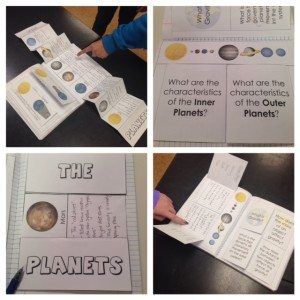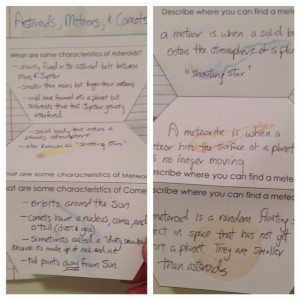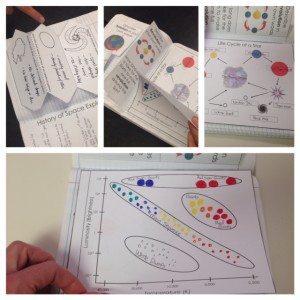As you already know I’m a huge proponent of interactive notebook pages for each of the units that I teach. I’ve written a blog post on the Top 5 reasons teachers should be using interactive notebooks in their science classrooms if you’re interested in hearing my reasoning behind them.
My space unit is one that I really enjoy teaching and students the students are probably most interested in it also. I have created a series of space interactive notebook pages and templates that I use in my own classroom and want to show you how I use them.
Included in the product are the following activities:
- Lunar cycle flippable, plus bonus blank vocabulary flippable to create your own class vocabulary list
- Moon phases basics flippable
- 3 full-page flippable that covers the lunar cycle and moon phases including perspectives from both space and Earth.
- Moon phases naming and shading activity
- Blank lunar calendar to track moon phases for whatever month you are working in
- Why we have seasons flippable
- Rotation vs. Revolution flippable
- Lunar eclipse vs. Solar eclipse flippable
- Spring tides vs. Neap tides flippable
- History of space exploration timeline (1955-current labels included, but left blank otherwise)
- Weight vs. Mass Venn diagram
- Exploring gravity flippable
- How much would you weigh on every planet activity
- Inner vs Outer planets flippable
- Asteroids, Meteors and Comets accordion
- Meteors, Meteorites and Meteoroids accordion
- Massive planets accordion
- Galaxies accordion
- H-R diagram flippable which includes the life cycle of a star
- Photo examples of all the activities in action
The lunar cycle and moon phases are always one of my most challenging subjects to teach, but I feel that with the right hands-on activities and journal entries that students find the concept much easier to understand. I use 5 different INB activities to drive home the concept. I use a vocabulary flippable, and a basic concepts flippable with it. Once we have explore the moon phases using my lunar phases station lab I then work with them on a flippable that shows the moon phases from different perspectives (as seen from Earth and from Space). One of the common misconceptions is that the Moon is somehow lit differently as it orbits the Earth. The moon is always half lit, but it’s our perception that makes us see different phases.
Download All 7 of My Best-Selling Interactive Notebooks for One Low Price
During this time I also discuss the lunar cycle as how long it takes to rotate around the Earth and to change from one phase to the next. At this point the student should be able to complete the activity where they have to fill out the moon phases and name each of them. The last activity that we do is look at a calendar and make predictions about what phases will come next and when. I have included a blank calendar that can be adapted to any month.

The next topic is seasons and what causes them. The activity that I created can be glued into a journal or used as a standalone activity. The beauty of this activity is that it not only allows the students to see the position of earth as it relates to the sun, but it also shows the months as the Earth orbits. It includes 4 Earth’s that all have the axis so that you can show how the tilt affects the seasons. Underneath the model there is a place to write notes for each season. There is also a page where my students have to discuss the difference between rotation and revolution and the time that it takes for each to happen.
.jpg)
.jpg)
When I discuss lunar and solar eclipses I use a flippable that shows the position of the Earth, Moon, and the Sun. The students have to tell me what each eclipse is and describe the positions of each of the Earth, Moon, and Sun. During this time we also discuss spring and neap tides and what role the moon plays on them. It’s my opinion that students need a strong visual of this in order to understand it.
.jpg)
The next set of activities deals with gravity. There are some basic rules of gravity and such that we discuss but then we get into how the force of gravity can change on each planet due to its mass. There is a fun activity where I have the students determine how much they would weigh on different planets based on their weight on Earth. We also compare and contrast mass and weight using a Venn diagram.

When I taught 6th grade we did a whole unit on planets. The solar system has also fascinated me and this interactive notebook page will start your unit off right by giving your kids something that they will enjoy. The planets notes really look awesome in the student journals. There is a blank space on each planet for student notes. We also discuss the differences between the inner and outer planets on another one of the templates. It opens up for student notes on the inside.

Another thing we cover during the solar system are comets, meteors and asteroids. We also cover the differences between meteor, meteorites, and meteoroid. I provide my student with easy to visualize accordion style graphic organizer when discussing these concepts.

The last few units that are with the templates focus on galaxies, the H-R diagram and the life cycle of the star. The H-R diagram and life cycle fit together onto one page of the journal similar to the season pages above. That goofy x-axis always messes them up on the test so be sure and hit that. It basically goes against everything they know about an xy-chart up until this point.

You can download all of these templates from my TPT store. I think that you students will really enjoy working with them.

Download Over $100 in FREE Resources
For Middle School Science
Simply create a login below and gain immediate access to a selection of our Kesler Science product line worth $100 - for FREE. There's a full version of every product type! You'll also join tens of thousands of middle school science teachers who receive timely tips and strategies straight to their inbox.




